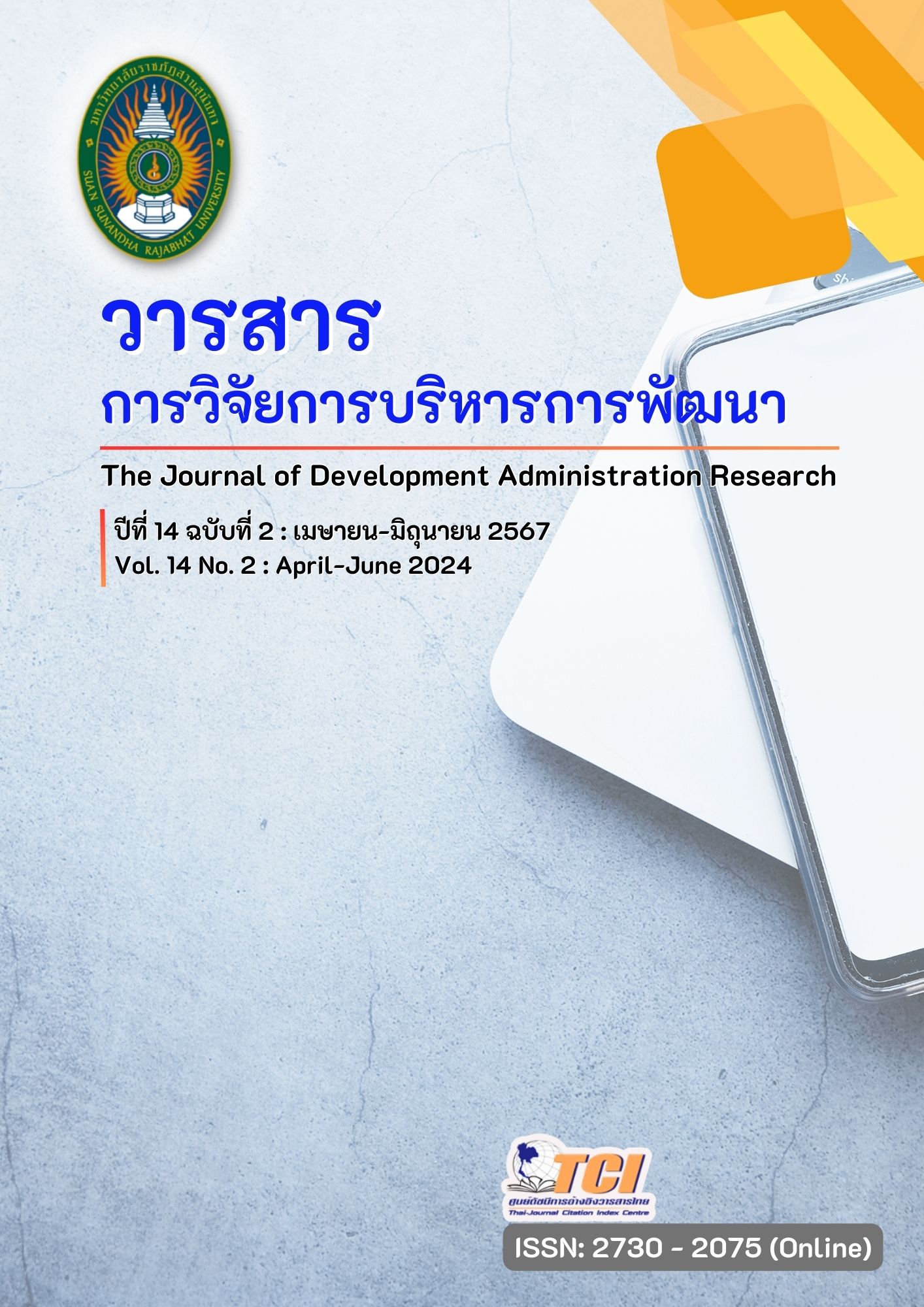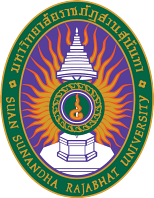การใช้แอปพลิเคชันของธนาคารพาณิชย์เพื่ออรรถประโยชน์และสุนทรียะ ในเขตกรุงเทพมหานครและปริมณฑล
คำสำคัญ:
ธนาคารพาณิชย์, อรรถประโยชน์, สุนทรียะบทคัดย่อ
บทความนี้มีวัตถุประสงค์เพื่อ 1) เพื่อเปรียบเทียบระดับการยอมรับคุณค่าของผู้ใช้บริการแอปพลิเคชันธนาคารพาณิชย์ในเขตกรุงเทพมหานครและปริมณฑลจำแนกตามกลุ่มอรรถประโยชน์และสุนทรียะ 2) เพื่อศึกษาปัจจัยที่ส่งผลต่อการยอมรับคุณค่าของผู้ใช้บริการแอปพลิเคชันธนาคารพาณิชย์กรุงเทพมหานครและปริมณฑลจำแนกตามกลุ่มอรรถประโยชน์และสุนทรียะ เครื่องมือที่ใช้เก็บรวบรวมข้อมูล โดยใช้แบบสอบถามออนไลน์ สถิติที่ใช้ในการวิเคราะห์ข้อมูล ได้แก่ โดยใช้สถิติเชิงอนุมาน ด้วยวิธีการวิเคราะห์แบบจำลองสมการถดถอยเชิงเส้นตรง
ผลการวิจัยพบว่า 1) ผลที่ได้จากการศึกษาพบว่า ปัจจัยด้านการรับรู้การทำงานข้ามแพลตฟอร์ม,การรับรู้จำนวนเติมเต็ม, การรับรู้ประโยชน์, การรับรู้ด้านเทคนิค, การรับรู้คุณค่า ที่ส่งผลต่อระดับการยอมรับคุณค่าการใช้งานแอปพลิเคชันธนาคารพาณิชย์สำหรับการใช้จ่ายสินค้าและบริการ 2) ผลที่ได้จากการศึกษาในมิติด้านสุนทรียะ พบว่าปัจจัยด้านการรับรู้ค่าธรรมเนียม ไม่ส่งผลต่อพฤติกรรมความตั้งใจใช้งานแอปพลิเคชันธนาคารพาณิชย์สำหรับการใช้จ่ายสินค้าและบริการ ด้วยการนำทฤษฎีการเลือกของผู้บริโภคและการตัดสินใจจากการวิจัยทางเศรษฐศาสตร์และการตลาดมาใช้ การศึกษาครั้งนี้จะพัฒนารูปแบบการยอมรับตามมูลค่า (VAM) และอธิบายลูกค้า การประยุกต์ของธนาคารพาณิชย์เพื่อการใช้ประโยชน์และความพึงพอใจในเขตกรุงเทพฯ และปริมณฑลจากมุมมองของการเพิ่มมูลค่าสูงสุด ผลการวิจัยแสดงให้เห็นว่าการรับรู้คุณค่าของผู้บริโภคต่อมูลค่าการใช้แอปพลิเคชันธนาคารพาณิชย์เพื่ออรรถประโยชน์และสุนทรียะ เป็นตัวกำหนดหลักของความตั้งใจในการรับรู้คุณค่า
เอกสารอ้างอิง
Al-ofeishat, H.A. & Rababah, M. (2012). Near Field Communication (NFC). IJCSNS International Journal of Computer Science and Network Security, 12(2), 93-99.
Bhattacharjee, T., & Pal, R. (2014). Network Externalities and Strategic Managerial Delegation in Cournot Duopoly: Is There a Prisoners’ Dilemma. Review of Network Economics, 12(4), 343−53.
Choi, K. S., Lee D. J. & Lee, K. D. (2022). Biased Managers with Network Externalities. Scottish Journal of Political Economy, 70(3), 201-216.
Davis, F.D. (1989). Perceived usefulness, perceived ease of use, and user acceptance of information technology. MIS Quarterly, 319-340.
Deci, E. L. (1975). Intrinsic Motivation. New York: Plenum Press.
Gupta, S. & Mela, C. F. (2008). What is a free customer worth. Harvard Business Review, 86, 102–109.
Hirose, K., S. H. Lee & T. Matsumura. (2017). Environmental Corporate Social Responsibility: A Note on the First-Mover Advantage under Price Competition. Economics Bulletin, 37(1), 214−221.
Katz, M. L. & Shapiro, C. (1985). Network externalities, competition and compatibility. American Economic Review, 75, 424–440.
Kim, H. W., Chan, H. C. & Gupta, S. (2007). Value-based adoption of mobile internet: An empirical investigation. Decision Support Systems, 43(1), 111-126.
Lin, C. P. & Bhattacherjee, A. (2008). Elucidating individual intention to use interactive information technologies: The role of network externalities. International Journal of Electronic Commerce, 13, 85–108.
Lu, Y., Zhou, T. & Wang, B. (2009). Exploring Chinese users’ acceptance of instant messaging using the theory of planned behavior, the technology acceptance model, and the flow theory. Computers in Human Behavior, 25, 29–39.
Mercado, I. T., Munaiah, N. & Meneely, A. (2016). The Impact of Cross-Platform Development Approaches for Mobile Applications from the User’s Perspective. WAMA’16, November 14, 2016, Seattle, WA, USA. pp. 43-49.
Pang, H., Ruan, Y. & Wang, Y. (2022). Unpacking Detrimental Effects of Network Externalities on Privacy Invasion, Communication Overload and Mobile App Discontinued Intentions: A Cognition-Affect-Conation Perspective. Behave. Sci., 13, 47.
Park, E., Baek, S., Ohm, J. & Chang, H. J. (2014). Determinants of player acceptance of mobile social network games: An application of extended technology acceptance model. Telematics and Informatics, 31(1), 3–15.
Subiyakto, A., et al. (2022). Network Externality Effects on Behavioral Intention to use Consumer Internet of Things Among Urban Citizens in Indonesia. Management Systems in Production Engineering, 31(2), 223-229.
Suryono, R. R., Budi, I & Purwandari, B. (2020). Challenges and Trends of Financial Technology (Fintech): A Systematic Literature Review. www.mdpi.com/journal/information. Information 2020, 11(12), 590; doi:10.3390/info11120590
Venkatesh, V., Morris, M. G., Davis, G. B., & Davis, F. D. (2003). User acceptance of information technology: Toward a unified view. MIS quarterly, 27(3), 425-478.
Vrechopoulos, A. P., Constantiou, I. D. & Mylonopoulos, N. (2002). Critical Success Factors for Accelerating Mobile Commerce Diffusion in Europe, 15th Bled Electronic Commerce Conference, e-Reality: Constructing the e-Economy Bled, Slovenia, (June 17–19, 2002).
Whitman, M. (2000). Understanding the Perceived Need for Complementary and Alternative Nutraceuticals: Lifestyle Issues. Clinical Journal of Oncology Nursing, 5(5),190-194.
Xing, M. & Lee, S-H. (2024). The Strategic Adoption of Environmental Corporate Social Responsibility with Network Externalities. The B.E. Journal of Theoretical Economics, 24(1), 399–418.
Yaseen, S. G. & Qirem, I. A. E. (2018). Intention to use e-banking services in the Jordaniancommercial banks. International Journal of Bank Marketing, 36(3), 557-571.
ดาวน์โหลด
เผยแพร่แล้ว
รูปแบบการอ้างอิง
ฉบับ
ประเภทบทความ
สัญญาอนุญาต
ลิขสิทธิ์ (c) 2024 วารสารการวิจัยการบริหารการพัฒนา

อนุญาตภายใต้เงื่อนไข Creative Commons Attribution-NonCommercial-NoDerivatives 4.0 International License.
บทความที่ได้รับการตีพิมพ์เป็นลิขสิทธิ์ของมหาวิทยาลัยราชภัฏสวนสุนันทา
ข้อความที่ปรากฏในบทความแต่ละเรื่องในวารสารวิชาการเล่มนี้เป็นความคิดเห็นส่วนตัวของผู้เขียนแต่ละท่านไม่เกี่ยวข้องกับมหาวิทยาลัยราชภัฏสวนสุนันทา และคณาจารย์ท่านอื่นๆ ในมหาวิทยาลัยฯ แต่อย่างใด ความรับผิดชอบองค์ประกอบทั้งหมดของบทความแต่ละเรื่องเป็นของผู้เขียนแต่ละท่าน หากมีความผิดพลาดใดๆ ผู้เขียนแต่ละท่านจะรับผิดชอบบทความของตนเองแต่ผู้เดียว




